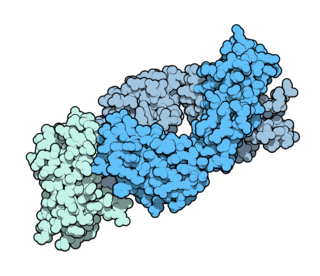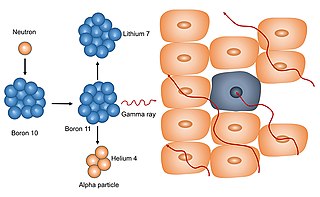Related Research Articles

Melanoma, also redundantly known as malignant melanoma, is a type of skin cancer that develops from the pigment-producing cells known as melanocytes. Melanomas typically occur in the skin but may rarely occur in the mouth, intestines or eye. In women, they most commonly occur on the legs, while in men they most commonly occur on the back. About 25% of melanomas develop from moles. Changes in a mole that can indicate melanoma include an increase in size, irregular edges, change in color, itchiness or skin breakdown.

Bufotenin is a tryptamine derivative related to the neurotransmitter serotonin. It is an alkaloid found in some species of toads, mushrooms and higher plants.

Cancer immunotherapy is the artificial stimulation of the immune system to treat cancer, improving on the immune system's natural ability to fight the disease. It is an application of the fundamental research of cancer immunology and a growing subspeciality of oncology.
Bufotoxins are a family of toxic steroid lactones or substituted Tryptamines of which some may or may not be toxic. They occur in the parotoid glands, skin and venom of many toads and other amphibians, and in some plants and mushrooms. The exact composition varies greatly with the specific source of the toxin. It can contain 5-MeO-DMT, bufagins, bufalin, bufotalin, bufotenin, bufothionine, epinephrine, norepinephrine, and serotonin. Some authors have also used the term bufotoxin to describe the conjugate of a bufagin with suberylarginine.
Bufagin is a toxic steroid C24H34O5 obtained from toad's milk, the poisonous secretion of a skin gland on the back of the neck of a large toad (Rhinella marina, synonym Bufo marinus, the cane toad). The toad produces this secretion when it is injured, scared or provoked. Bufagin resembles chemical substances from digitalis in physiological activity and chemical structure.

Bufotalin is a cardiotoxic bufanolide steroid, cardiac glycoside analogue, secreted by a number of toad species. Bufotalin can be extracted from the skin parotoid glands of several types of toad.

Sunitinib, sold under the brand name Sutent, is a medication used to treat cancer. It is a small-molecule, multi-targeted receptor tyrosine kinase (RTK) inhibitor that was approved by the FDA for the treatment of renal cell carcinoma (RCC) and imatinib-resistant gastrointestinal stromal tumor (GIST) on January 26, 2006. Sunitinib was the first cancer drug simultaneously approved for two different indications.

Alternative cancer treatment describes any cancer treatment or practice that is not part of the conventional standard of cancer care. These include special diets and exercises, chemicals, herbs, devices, and manual procedures. Most alternative cancer treatments do not have high-quality evidence supporting their use. Concerns have been raised about the safety of some of them. Some have even been found to be unsafe in certain settings. Despite this, many untested and disproven treatments are used around the world. Promoting or marketing such treatments is illegal in most of the developed world.

This article refers to the anti-tumor molecule, and not the a2iib3 integrin activation specific antibody of the same name

Ipilimumab, sold under the brand name Yervoy, is a monoclonal antibody medication that works to activate the immune system by targeting CTLA-4, a protein receptor that downregulates the immune system.

Leptomeningeal cancer is a rare complication of cancer in which the disease spreads from the original tumor site to the meninges surrounding the brain and spinal cord. This leads to an inflammatory response, hence the alternative names neoplastic meningitis (NM), malignant meningitis, or carcinomatous meningitis. The term leptomeningeal describes the thin meninges, the arachnoid and the pia mater, between which the cerebrospinal fluid is located. The disorder was originally reported by Eberth in 1870.

Arenobufagin is a cardiotoxic bufanolide steroid secreted by the Argentine toad Bufo arenarum. It has effects similar to digitalis, blocking the Na+/K+ pump in heart tissue.
Adoptive cell transfer (ACT) is the transfer of cells into a patient. The cells may have originated from the patient or from another individual. The cells are most commonly derived from the immune system with the goal of improving immune functionality and characteristics. In autologous cancer immunotherapy, T cells are extracted from the patient, genetically modified and cultured in vitro and returned to the same patient. Comparatively, allogeneic therapies involve cells isolated and expanded from a donor separate from the patient receiving the cells.

Bufothionine is a sulfur-containing compound which is present in the bufotoxins secreted by the parotoid gland of certain toads of the genera Bufo and Chaunus. This specific compound can be found in the skin of certain species of toad such as the Asiatic Toad, Chaunus arunco, Chaunus crucifer, Chaunus spinulosus, and Chaunus arenarum.

Neutron capture therapy (NCT) is a radio-therapeutic modality for treating locally invasive malignant tumors such as primary brain tumors, recurrent cancers of the head and neck region, and cutaneous and extracutaneous melanomas. It is a two-step procedure: first, the patient is injected with a tumor-localizing drug containing the non-radioactive isotope boron-10 (10B), which has a high propensity to capture low energy "thermal" neutrons. The neutron cross section of 10B is 1,000 times greater than that of the other elements, such as nitrogen, hydrogen, and oxygen, that are present in tissues. In the second step, the patient is radiated with epithermal neutrons, the sources of which in the past have been nuclear reactors and now are accelerators that produce higher energy epithermal neutrons. After losing energy as they penetrate tissue, the resultant low energy "thermal" neutrons are captured by the 10B atoms. The resulting fission reaction yields high-energy alpha particles that kill the cancer cells that have taken up sufficient quantities of 10B. All of the clinical experience to date with NCT has been with the non-radioactive isotope boron-10, and hence this radio-therapeutic modality is known as boron neutron capture therapy (BNCT). The use of another non-radioactive isotope, such as gadolinium (Gd), has been limited to experimental animal studies and has not been used clinically. BNCT has been evaluated clinically as an alternative to conventional radiation therapy for the treatment of malignant brain tumors such as glioblastomas, which presently are incurable, and more recently, locally advanced recurrent cancers of the head and neck region and, much less frequently, superficial melanomas primarily involving the skin and genital region.
Racotumomab is a therapeutic cancer vaccine for the treatment of solid tumors that is currently under clinical development by Recombio, an international public-private consortium with the participation of the Center of Molecular Immunology at Havana, Cuba (CIM) and researchers from Buenos Aires University and National University of Quilmes in Argentina. It induces the patient's immune system to generate a response against a cancer-specific molecular target with the purpose of blocking tumor growth, slowing disease progression and ultimately increasing patient survival.

Nivolumab, sold under the brand name Opdivo, is a medication used to treat a number of types of cancer. This includes melanoma, lung cancer, malignant pleural mesothelioma, renal cell carcinoma, Hodgkin lymphoma, head and neck cancer, urothelial carcinoma, colon cancer, esophageal squamous cell carcinoma, liver cancer, gastric cancer, and esophageal or gastroesophageal junction (GEJ) cancer. It is used by slow injection into a vein.

Arabinopyranosyl-N-methyl-N-nitrosourea, also known as Aranose (Араноза) is a cytostatic anticancer chemotherapeutic drug of an alkylating type. Chemically it is a nitrosourea derivative. It was developed in the Soviet Union in the 1970s. It was claimed by its developers that its advantages over other nitrosoureas are a relatively low hematological toxicity and a wider therapeutic index, which allows for its outpatient administration.
Viralytics Ltd is an Australian biotechnology company working in the field of oncolytic viruses, that is, viruses that preferentially infect and kill cancer cells. The company's oncolytic virus product, called Cavatak, is currently in clinical trials in metastatic melanoma and other cancers. The drug was granted Orphan Drug status in advanced melanoma in December 2005.

PD-1 inhibitors and PD-L1 inhibitors are a group of checkpoint inhibitor anticancer drugs that block the activity of PD-1 and PDL1 immune checkpoint proteins present on the surface of cells. Immune checkpoint inhibitors are emerging as a front-line treatment for several types of cancer.
References
- 1 2 "HuaChanSu". National Cancer Institute. Retrieved 17 November 2012.
- 1 2 3 4 "HuaChanSu May Slow Cancer Progression". News Medical. 25 September 2009. Retrieved 30 October 2012.
- 1 2 3 4 5 6 Meng, Zhigiang; Yang, P; Shen, Y; Bei, W; Zhang, Y; Ge, Y; Newman, RA; Cohen, L; Liu, L (2009). "Pilot Study of Huachansu in Patients with Hepatocellular Carcinoma, Non-Small Cell Lung Cancer, or Pancreatic Cancer". Cancer. NIHPA. 115 (22): 5309–5318. doi:10.1002/cncr.24602. PMC 2856335 . PMID 19701908.
- 1 2 3 4 Yang, Peiying. "Anti-proliferative activity of Huachansu, a Bufo toad skin extract, against human malignant melanoma cells". AACR Meeting Abstracts Online. Retrieved 30 October 2012.
- ↑ Anderson, M.D. "M. D. Anderson Examines Use of Toad Venom in Cancer Treatment". The University of Texas M.D. Anderson. Retrieved 30 October 2012.